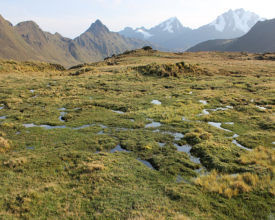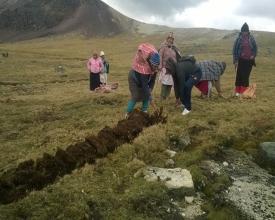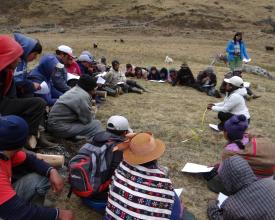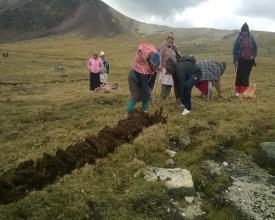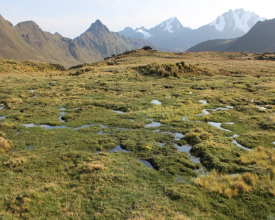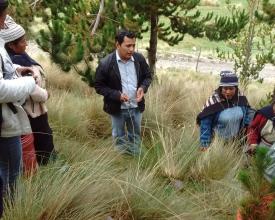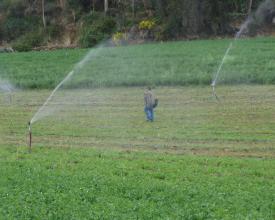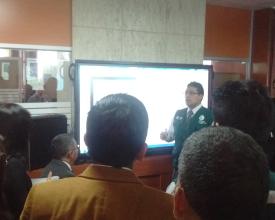
Water Resource Management in the Shullcas Sub-basin, Peru
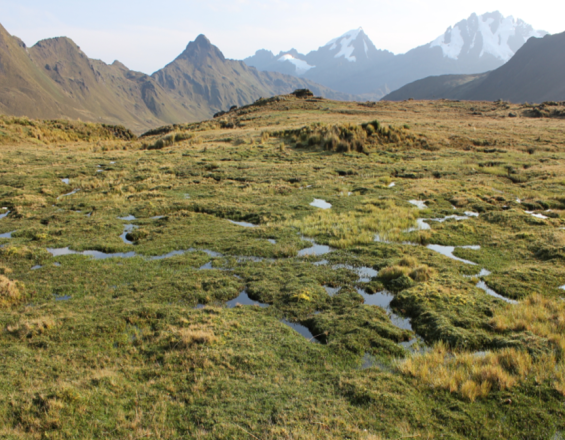
This solution seeks to ensure water supply in the Shullcas river basin, which is threatened by the progressive melting of the Huaytapallana snow-capped mountain that has been altering its water regime. The solution was designed under the integrated basin management approach, promoting better water resource management on both the supply and demand sides. Actions at the local level were adjusted based on an analysis of climate capacity and vulnerability, which identified the dependence between the livelihoods of the population and the ecosystems. Adaptation actions include:
- Reforestation and conservation of natural grasslands and pastures to promote water retention.
- Improved practices to reduce water consumption in agriculture.
- Improved water use practices in urban areas.
- Capacity building at the local and regional level to manage a mechanism of retribution for ecosystem services that seeks the sustainability of the solution.
Context
Challenges addressed
- The progressive deglaciation of the Huaytapallana snow-capped mountain threatens the provision of water resources during the dry season, putting the livelihoods of the population and the water supply in the city of Huancayo at risk. The drastic fluctuations that will occur in the hydrological cycle will generate an unstable water supply, also affecting the retention of water for supplying the lowlands.
- This climatic condition is compounded by poor natural resource management due to the high level of rural poverty (82% of the population lives in poverty and 25% in extreme poverty), which reduces the ecosystem's natural water regulation capacity.
- In addition, the parceling of communal land makes it more complex to make decisions on the implementation of practices in the territory, as it requires agreements both at the communal level and with each family in charge of the plot.
Location
Process
Summary of the process
The solution involves developing components that consolidate the sustainability of water resource management in the sub-basin. For its design, a climate vulnerability and capacity analysis (BB1) was carried out, in which the vulnerable livelihoods of the local population were identified, which depend on ecosystem services, based on which measures were included in the design to contribute to the recovery of natural infrastructure such as reforestation and conservation of grasslands and natural pastures to promote water retention through the recovery and proper management of ecosystems, and to ensure the productivity of these ecosystems on which the population depends (BB2), which were complemented with measures aimed at reducing water consumption in a future scenario of water stress:improvement of water use practices at the rural level (BB3) , and promotion of water saving practices at the urban level (BB4). BB5, promotion of a mechanism for the retribution of ecosystem services, leads with management aspects, improving the institutional framework at the local and regional level and providing sustainability to the implemented measure.
Building Blocks
Capacity and climate vulnerability analysis in the Shulllcas river basin.
The Climate Vulnerability and Capacity Analysis (CVCA) methodology seeks to understand the socio-economic dimensions of vulnerability to climate change and to identify adaptation actions to be implemented. The methodology relates the impacts of climate change to the livelihoods of the rural population, including the ecosystems on which they depend for their subsistence. Thus, one of the main rural incomes comes from livestock farming, which depends on natural pastures. It is an ecosystem that, in addition to providing food for livestock, in good conditions provides hydrological ecosystem services that ensure the water supply in the Shullcas River sub-basin. This is the main water source for the rural settlements that live along its banks and for the city of Huancayo. Its waters are used for human consumption, agriculture, livestock, fish farming, and power generation.
The CVCA provided a qualitative baseline and identified ecosystem-based community adaptation components/strategies such as reforestation and conservation of grasslands and natural pastures that adjusted the initial designs. Finally, the CVCA strengthened capacities and promoted participation.
Enabling factors
- Starting from creating a common understanding among both the technical team and the analyzed community in terms of technical terms and objectives of the analysis.
- A fairly complete but flexible methodology that allowed adapting to the context.
- Adequate identification of the actors integrating women and generational and role differences was important to obtain more complete and valid results.
Lesson learned
- Tools need to be adapted to the local context and circumstances in which they will be applied.
- Capacity building is required within the project team to understand and facilitate learning of key climate change and adaptation concepts and tools.
- It is important to improve analysis through partnerships with specialized institutions and to foster greater coordination among the various participants.
- The problems in the field are diverse, and proper analysis in the CVCA requires the necessary technical expertise.
- Strengthen the exhaustive analysis of the results related to climate hazards, to identify the chain of causality that allows for an adequate design of measures.
- The CVCA allows the community to internalize the problem and feel part of the solution, promoting greater participation.
Reforestation and conservation of natural grasslands and pastures to promote water retention
The aim was to recover the ecosystems, their water ecosystem services and the service of providing food for livestock. Awareness-raising and agreements were worked on at both the community and family levels. For the implementation, agreements were signed for the installation and maintenance at the family level, since the community has given them possession of the plots of land. In the first stage the project assumed all the costs and later when the benefits were visible, the community contributed their labor. It was implemented:
Reforestation: To contribute to the regulation of the hydrological regime and the health of the ecosystems.
Conservation of natural grasslands: To prevent soil erosion, maintain adequate vegetation cover, enhancing wetland functions, maximizing water infiltration and retention capacity. Includes:
- Temporary closures, in degraded areas that can recover naturally, and that will be subjected to a total restriction of use for a minimum period of three years.
- Construction of infiltration ditches.
- Installation and management of pastures: formation of silvopastures, reintroduction of natural pastures.
Enabling factors
- Concern of the population and institutions about the effects of climate change (deglaciation).
- Platforms for interinstitutional work in which multiple institutions converge.
- Organizational and leadership capacities of the community.
- Local capacities to develop research and monitoring.
- Integration of the measure into a larger strategy such as Integrated Water Resource Management and Community Development Plans.
- Trust building process.
Lesson learned
- Technical accompaniment is required through field promoters, who provide personalized technical assistance and take advantage of community meetings for training.
- Awareness-raising and appropriate communication of research results on changes in the water regime and the role of vegetation cover in protecting the soil and improving rainwater filtration have given the community and families a practical understanding that water will be scarcer or more irregular in the future and what actions they can take to minimize this effect. Therefore, they decided to take care now, using systems to reduce water consumption and taking actions to recover the ecosystem.
- The community is required to visualize the benefits of the intervention to facilitate their contribution with their own contributions, especially labor.
- Due to the parcelization of the territory, the implementation of the practices requires not only agreements with the community but also with the families that own the land.
Improved water use practices to compensate for reduced water availability for agriculture.
A series of measures have been implemented to improve water use, such as the implementation of technified irrigation, improvement of lined canals, and the use of crops resistant to water stress. In the lower zone of the Shullcas sub-basin, 6 technified irrigation systems have been implemented incorporating 261 ha of agricultural land and 2 improved irrigation canals for 175 ha. The families use them, allowing for the efficient use of irrigation water, with results in improved and increased agricultural production, which also represents an improvement in family income (previously only during the rainy season).
Currently, an irrigation system operation and maintenance committee has been formed and has received training to ensure the sustainability of the infrastructure. The training topics have been basically related to operation and maintenance. Both operation and maintenance must be systematic and meticulous, repairs must be carried out on time and must be of good quality and establish the original performance in terms of both capacity and function, ensuring the system's operability throughout its useful life.
Enabling factors
- A proper diagnosis of the problem for a better design of the measure.
- Technological changes and human capabilities are required.
- The adaptation of new forms of agricultural and forestry production to the impact of glacial retreat and climate change will be expressed in a livestock and forestry activity that will continue to develop, but with technological changes, with improved human capacities strengthened by training and awareness, and in a planned form of agricultural production.
Lesson learned
The implementation of this component has clearly identified the need to know and prioritize crops that are more resistant to extreme weather conditions such as frost and hailstorms; in the Shullcas sub-basin, native potatoes and quinoa have proven to be an excellent alternative.
Improved water use practices in urban areas
The purpose of this component was to raise awareness among the urban population in order to promote water-saving practices to meet pending social demand. A call was made to the population to save water and avoid, for example, watering gardens, washing cars, the so-called portable pools that require 7,000 liters of water to be filled, an amount equivalent to 15 days of family consumption, according to figures provided by the National Superintendence of Sanitation Services - Sunass.
Simple and key messages were transmitted, some of which were: a family (of six members) in the cities should consume between 15 and 18 cubic meters per month, however, the real consumption is between 20 and 25, "so families are wasting the liquid".
The adoption of changes in household consumption habits was promoted, for example, introducing a bottle of water in the toilet tank, which would save up to two liters of liquid per flush. Consider taking five-minute showers and turning off the faucet while soaping up. This could save up to 40 liters of water.
Enabling factors
- The support of the regional government is important because guidance and political backing is needed, but also the participation of business associations, consumer associations, trade unions, among others.
- A communication campaign designed for the specific type of audience (social, cultural, etc.) is required to be effective. For example, problems were highlighted, but practical and immediate solutions were also provided.
- Inter-institutional alliances, such as EPS Sedam, Sunass, etc.
Lesson learned
- Campaigns must be appropriate to the context and target audience. While it is important to draw attention to the problems, it is equally important to provide practicable solutions.
- To achieve attitudinal changes about water use, collaboration between public, private and civil society actors is required.
Promotion of a mechanism for the retribution of ecosystem services
The mechanism for the retribution of ecosystem services (MRSE) seeks to ensure the sustainability of the adaptation measures designed. To identify the contributors (who provide the ecosystem service) and retributors (users of the service who contribute resources), a rapid hydrological diagnosis was prepared, which also characterized the sub-basin and identified the priority ecosystem service and water demand. In order to reach agreements, both parties had to be made aware of the benefits and their responsibilities. The contributors are: the authorities, users of the Huancayo water and sanitation service provider (SEDAM Huancayo), individual farmers and organizations in the sub-basin, and the contributor is the Acopalca Community.
The MRSE steering committee was then formed with the participation of the institutions involved. Within this framework, an agreement was signed whereby the urban population (Huancayo) reimburses the Acopalca community for ecosystem conservation by creating a fund to develop sustainable ecosystem management projects. In addition, SEDAM Huancayo, in updating its Optimized Master Plan, incorporates the MRSE, including investment projects for recovery, conservation, and sustainable use.
Enabling factors
- The current legal framework of the law on mechanisms for the retribution of ecosystem services and its regulations.
- Political decision for the implementation of ESRM in water and sanitation based on successful experiences in this system.
- Approved technical tools that make it possible to execute the steps to implement the mechanism, such as the rapid hydrological diagnosis.
- State institutions with functions that promote the SRM initiative.
Lesson learned
- It is important to have national standards in relation to the ESMR, as they facilitate the feasibility of the necessary inputs such as the rapid water diagnosis and the project profile, as well as identifying who would be the contributor within the ESMR.
- All sub-basin stakeholders (civil society, state agencies, private enterprise, etc.) must participate in the design and implementation of the mechanism.
- It is necessary to build and maintain a common vision among the various stakeholders, contributing to the sense of joint work and benefit for the different interests (agricultural irrigation, livestock, drinking water, etc.).
- It is important to insert a monitoring component in the MRSE projects to determine how much water is gained and also to readjust the implementation.
- A good governance platform is required to be responsible for the monitoring system in the medium and long term.
- Effective communication strategies and communication tools are needed to leverage resources and effectively convey the objectives of the mechanism.
Resources
Impacts
Through 5 research projects developed in partnership with universities in the region, the impact on water recharge was proven:
- Quinual (Polylepis racemosa) plantations contribute positively to the water recharge process compared to other species, capturing 47% of precipitation.
- The Colle(Buddleja coriacea) plantations have a smaller contribution than the quinual, but offer a significant contribution, capturing 17.8% of the incident precipitation.
- Infiltration ditches contribute between 12% and 18.77% of rainfall capture.
- Natural pastures contribute 32.68% of rainfall capture to water recharge, which improves if evaluated within a silvopastoral system. This activity is the most recommendable after a cost-benefit analysis; in addition, it does not interfere with the diverse vegetation cover of this life zone.
Some producers in the community of Acopalca say that the recovery and formation of wetlands is visible, emphasizing the recovery of pasture biodiversity, finding species that are more palatable for livestock.
In the Acopalca community, a new source of income was generated by harvesting the mushrooms that form in the area forested with pine trees, despite the fact that pine trees do not contribute positively to water recharge.
Beneficiaries
- Direct: 350 community members of the Acopalca community.
- Indirect: 120,000 community members of the sub-basin communities, city of Huancayo.
Sustainable Development Goals
Story
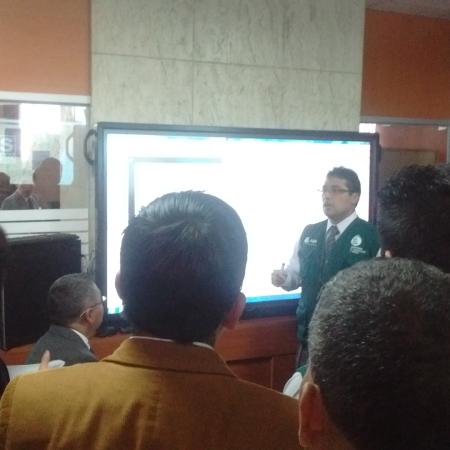
High mountain ecosystems are highly vulnerable to the variability of hydrological patterns, putting subsistence agriculture and thus livelihoods at risk. To the extent that the lowlands depend on the tributary watercourses of the high Andes, the impacts will also be felt downstream. This is the case of the Shullcas sub-basin, which has at its headwaters the Huaytapallana glacier, 40% of whose runoff contributes to the drinking water supply in the city of Huancayo (500,000 inhabitants), as well as irrigation water used for agricultural and livestock activities. Concern about the deglaciation of the Huaytapallana river prompted stakeholders to create a committee to promote a mechanism for the reimbursement of water ecosystem services - MRSE. The committee was created to coordinate the efforts of different institutions linked to water resources to develop actions for the protection, conservation or restoration of water ecosystem services provided by the Shullcas River sub-basin. This Committee is led by the Regional Government, with the support and advice of the Ministry of the Environment (Minam). It also has the active participation of the Huancayo Water Service Provider Company (SEDAM), the Irrigation Board, CARE PERU, among other organizations. The Acopalca community also participates in this committee, where SEDAM's water intake is located for subsequent distribution in the city of Huancayo.
As part of the work of the driving committee, the Public Investment Project (PIP) "Recovery of the ecosystemic service of water regulation of the Huacracocha lagoon micro-watershed - Acopalca Community, district and province of Huancayo, Junín region" has been developed. This project seeks to implement actions for the conservation of water sources as well as sustainable productive activities in the community of Acopalca.
Based on this "green" PIP and current regulations that favor the implementation of compensation mechanisms for ecosystem services between Huancayo and Acopalca, the community has signed a compensation agreement between the contributor (city of Huancayo) and the contributor (community of Acopalca). With this agreement, the community will have the financial and technical resources to adapt its farming methods and optimize water use for itself and the city of Huancayo.
